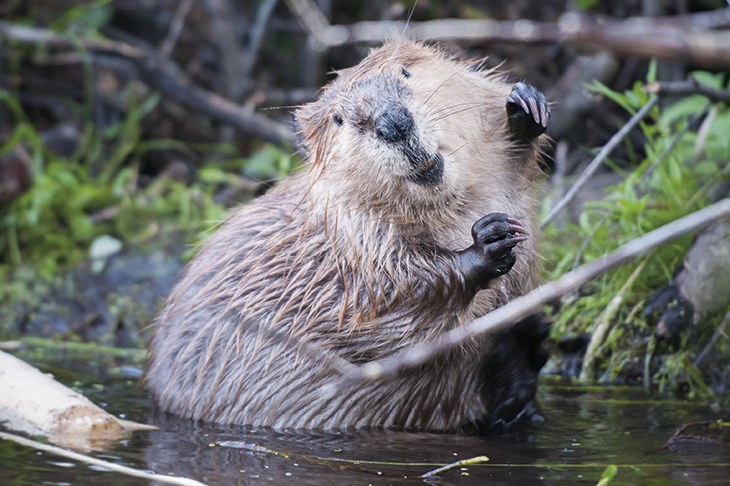I know a magical West Country woodland where a sunlit stream meanders through the great oaks, with a series of neatly dammed pools that hum with life; dragonflies and mayflies, swallows, swifts, kingfishers, amphibians and small fish teem here in numbers rarely seen in Britain. The birdsong is cacophonous. The water’s edge is lined with the fresh growth of willow, hazel and alder, artfully coppiced as if by a skilful gardener. This wood happens to be home to a family of reintroduced beavers.
Beavers were eradicated from Britain centuries ago, hunted for their fur and for the valuable castoreum oil which is found in sacs under their tails. They are highly territorial animals, living in small family groups comprising a single pair and their ‘kits’, along with an assortment of adolescent offspring who tend to hang around until their second or third year. They use water as a means of escape, so while their food (the bark, twigs and shoots of trees, shrubs and other plants) is to be found on land, beavers never travel far from water.
Life is straightforward for beavers with prized territories along broad stretches of water. But when these areas are occupied, young beavers looking to establish a territory of their own must make their way into streams and tributaries. It is here that they really make an impact. For without adequate deep water, beavers set about creating it themselves, using stones, branches and mud to construct small dams, behind each of which they dig out a large pool that fills with water. Before long the stream resembles the flooded steps of a terraced rice paddy. These wetlands soon abound with life.
Streams braided with beaver pools play a critical role in protecting us from flooding, as well as from seasonal drought. Without them, winter rainfall brings a torrent of water that rushes downstream, causing flash flooding. That gives way to dry, lifeless gullies in the summer once the water has gone. Beaver dams slow the flow of water, giving nature time to sift it of sediment and impurities, and release it evenly through the year.
In each beaver territory is a ‘lodge’ where the family finds refuge in the daytime: a large dome made of sticks, plastered with mud, and comprising a series of dry inner chambers, built with the entrance on the underside, beneath the water. These lodges provide a home for countless other species. Nesting birds, hibernating reptiles and amphibians, hedgehogs and small rodents all use beaver lodges for cover.
In areas where beavers do present a problem — such as where manmade ditches keep low-lying arable land from being flooded — they must be managed, preferably non–lethally. But opposition to the return of beavers mostly arises from misunderstanding. There are worries that migratory fish such as salmon and trout might be unable to make it past beaver dams, which ignores the fact that they co-evolved over millions of years with beavers. And some people object to the ‘mess’ created by beavers along the water’s edge. Considering that the majority of our land is stripped, cultivated, tidied and managed by humans, can’t we allow nature a bit of free rein along our watercourses?
The return of beavers to Britain, along with all that they do to bring life into our landscapes, is a marvel.
Got something to add? Join the discussion and comment below.
Get 10 issues for just $10
Subscribe to The Spectator Australia today for the next 10 magazine issues, plus full online access, for just $10.
You might disagree with half of it, but you’ll enjoy reading all of it. Try your first month for free, then just $2 a week for the remainder of your first year.














Comments
Don't miss out
Join the conversation with other Spectator Australia readers. Subscribe to leave a comment.
SUBSCRIBEAlready a subscriber? Log in